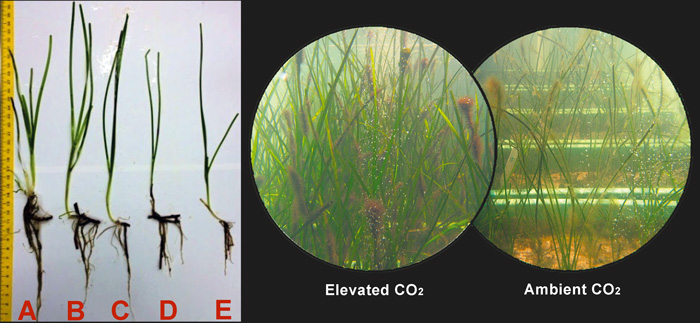| Follow @co2science |
Paper Reviewed
Zimmerman, R.C., Hill, V.J., Jinuntuya, M., Celebi, B., Ruble, D., Smith, M., Cedeno, T. and Swingle, W.M. 2017. Experimental impacts of climate warming and ocean carbonation on eelgrass Zostera marina. Marine Ecology Progress Series 566: 1-15.
In an intriguing new paper published in the journal Marine Ecology Progress Series, Zimmerman et al. (2017) investigate the controversial topic of ocean acidification, or as they more correctly describe it, ocean carbonation.
Writing as background for their work, the eight U.S. researchers note how numerous studies have shown that elevated levels of atmospheric carbon dioxide not only increase terrestrial plant photosynthesis, but also enhance the productivity of aquatic ecosystems. In particular, they cite studies documenting how the dissolution of CO2 into surface waters of the world's oceans (i.e., ocean acidification or ocean carbonation) has benefited certain taxonomic groups, including nitrogen-fixing cyanobacteria, coccolithophores and seagrasses, the latter of which group was the focus of their present study. Concentrating specifically on eelgrass (Zostera marina), Zimmerman et al. set out "to quantify the extent to which CO2 enrichment can improve the ability of eelgrass to tolerate stressful summer temperatures." Their reason for selecting eelgrass was due to the relatively large number of CO2 enrichment studies previously performed on this macroalgal species, plus the important role it plays in "sediment stabilization and habitat provision for many ecologically and economically important invertebrates and fish."
Their experiment was conducted at the Virginia Aquarium & Marine Science Center, where they pumped seawater from a nearby estuary into a series of outdoor aquaria containing eelgrass transplants. The aquaria were maintained at 5 different pH values (7.7, 7.4, 6.9, 6.5 and 6.1) for a period of 18 months (June 2013 through November 2014) by injecting CO2 into the airstream in each tank. Because this was an outdoor experiment, all treatments were exposed to natural fluctuations in total solar radiation, temperature and salinity.
Results of their study revealed that ocean carbonation increased eelgrass survival, shoot number, size, and growth. By the end of the experiment, eelgrass plants in the highest CO2 seawater treatment were some three times larger than the plants growing under ambient conditions. Visual documentation of such differences can been seen in the figure below. Elevated CO2 also stimulated leaf sugar concentration by five-fold, of which accumulation the authors say it "may be critical in regulating the flowering process in eelgrass," which rates under elevated CO2 were between 3 and 5 times higher than the 10 percent flowering rate typically observed under ambient conditions.
Another major benefit of ocean carbonation was the surprising observation that elevated CO2 mitigated the impact of warm temperatures on eelgrass growth and survival. As described by Zimmerman et al., elevated CO2 "prevent[ed] shoot losses during the warm summer when water temperature exceeded the 25°C threshold for thermal stress" and it "eliminated the lethal effects of temperature."
In light of the above, Zimmerman et al. conclude "it appears that ocean carbonation (ocean acidification) can serve as a quantitative antagonist to counter the negative impact of climate warming on eelgrass growth and survival," while adding that their findings "reinforce the emerging paradigm that eelgrass may benefit significantly from a high-CO2 world." And that is news worth reporting and celebrating!

Figure 1. (Left panel) Representative eelgrass sizes under the various pH treatments (A = 6.1, B = 6.5, C = 6.9, D = 7.4 and E = 7.7 or ambient). (Right panel) Illustration of the differences in eelgrass density and shoot size under elevated and ambient CO2 conditions. Source: Zimmerman et al. (2017).




